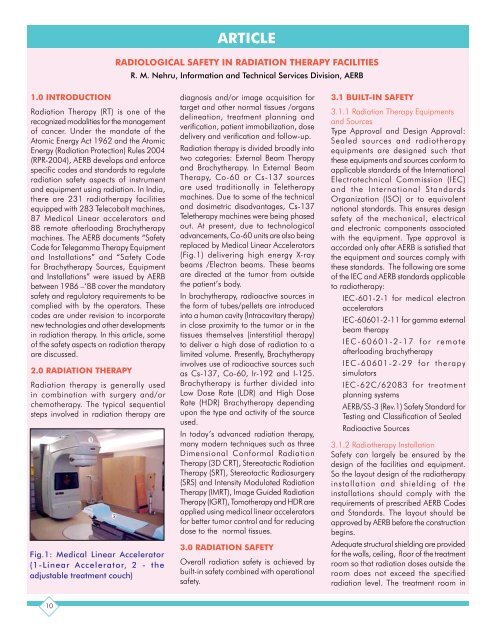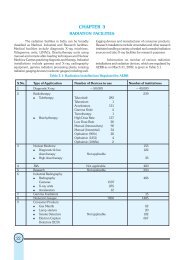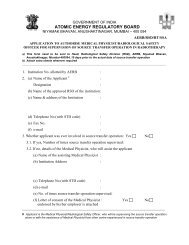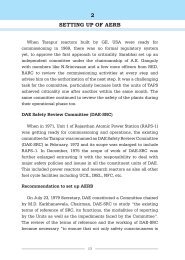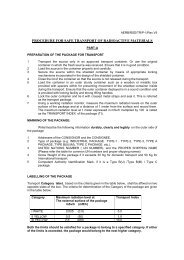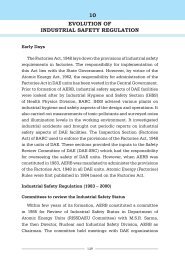Vol 20 No 1&2 - Atomic Energy Regulatory Board
Vol 20 No 1&2 - Atomic Energy Regulatory Board
Vol 20 No 1&2 - Atomic Energy Regulatory Board
Create successful ePaper yourself
Turn your PDF publications into a flip-book with our unique Google optimized e-Paper software.
ARTICLE<br />
RADIOLOGICAL SAFETY IN RADIATION THERAPY FACILITIES<br />
R. M. Nehru, Information and Technical Services Division, AERB<br />
1.0 INTRODUCTION<br />
Radiation Therapy (RT) is one of the<br />
recognized modalities for the management<br />
of cancer. Under the mandate of the<br />
<strong>Atomic</strong> <strong>Energy</strong> Act 1962 and the <strong>Atomic</strong><br />
<strong>Energy</strong> (Radiation Protection) Rules <strong>20</strong>04<br />
(RPR-<strong>20</strong>04), AERB develops and enforce<br />
specific codes and standards to regulate<br />
radiation safety aspects of instrument<br />
and equipment using radiation. In India,<br />
there are 231 radiotherapy facilities<br />
equipped with 283 Telecobalt machines,<br />
87 Medical Linear accelerators and<br />
88 remote afterloading Brachytherapy<br />
machines. The AERB documents “Safety<br />
Code for Telegamma Therapy Equipment<br />
and Installations” and “Safety Code<br />
for Brachytherapy Sources, Equipment<br />
and Installations” were issued by AERB<br />
between 1986 –‘88 cover the mandatory<br />
safety and regulatory requirements to be<br />
complied with by the operators. These<br />
codes are under revision to incorporate<br />
new technologies and other developments<br />
in radiation therapy. In this article, some<br />
of the safety aspects on radiation therapy<br />
are discussed.<br />
2.0 RADIATION THERAPY<br />
Radiation therapy is generally used<br />
in combination with surgery and/or<br />
chemotherapy. The typical sequential<br />
steps involved in radiation therapy are<br />
Fig.1: Medical Linear Accelerator<br />
(1-Linear Accelerator, 2 - the<br />
adjustable treatment couch)<br />
diagnosis and/or image acquisition for<br />
target and other normal tissues /organs<br />
delineation, treatment planning and<br />
verification, patient immobilization, dose<br />
delivery and verification and follow-up.<br />
Radiation therapy is divided broadly into<br />
two categories: External Beam Therapy<br />
and Brachytherapy. In External Beam<br />
Therapy, Co-60 or Cs-137 sources<br />
are used traditionally in Teletherapy<br />
machines. Due to some of the technical<br />
and dosimetric disadvantages, Cs-137<br />
Teletherapy machines were being phased<br />
out. At present, due to technological<br />
advancements, Co-60 units are also being<br />
replaced by Medical Linear Accelerators<br />
(Fig.1) delivering high energy X-ray<br />
beams /Electron beams. These beams<br />
are directed at the tumor from outside<br />
the patient’s body.<br />
In brachytherapy, radioactive sources in<br />
the form of tubes/pellets are introduced<br />
into a human cavity (Intracavitary therapy)<br />
in close proximity to the tumor or in the<br />
tissues themselves (interstitial therapy)<br />
to deliver a high dose of radiation to a<br />
limited volume. Presently, Brachytherapy<br />
involves use of radioactive sources such<br />
as Cs-137, Co-60, Ir-192 and I-125.<br />
Brachytherapy is further divided into<br />
Low Dose Rate (LDR) and High Dose<br />
Rate (HDR) Brachytherapy depending<br />
upon the type and activity of the source<br />
used.<br />
In today’s advanced radiation therapy,<br />
many modern techniques such as three<br />
Dimensional Conformal Radiation<br />
Therapy (3D CRT), Stereotactic Radiation<br />
Therapy (SRT), Stereotactic Radiosurgery<br />
(SRS) and Intensity Modulated Radiation<br />
Therapy (IMRT), Image Guided Radiation<br />
Therapy (IGRT), Tomotherapy and HDR are<br />
applied using medical linear accelerators<br />
for better tumor control and for reducing<br />
dose to the normal tissues.<br />
3.0 RADIATION SAFETY<br />
Overall radiation safety is achieved by<br />
built-in safety combined with operational<br />
safety.<br />
3.1 BUILT-IN SAFETY<br />
3.1.1 Radiation Therapy Equipments<br />
and Sources<br />
Type Approval and Design Approval:<br />
Sealed sources and radiotherapy<br />
equipments are designed such that<br />
these equipments and sources conform to<br />
applicable standards of the International<br />
Electrotechnical Commission (IEC)<br />
and the International Standards<br />
Organization (ISO) or to equivalent<br />
national standards. This ensures design<br />
safety of the mechanical, electrical<br />
and electronic components associated<br />
with the equipment. Type approval is<br />
accorded only after AERB is satisfied that<br />
the equipment and sources comply with<br />
these standards. The following are some<br />
of the IEC and AERB standards applicable<br />
to radiotherapy:<br />
IEC-601-2-1 for medical electron<br />
accelerators<br />
IEC-60601-2-11 for gamma external<br />
beam therapy<br />
IEC -60601-2-17 for remote<br />
afterloading brachytherapy<br />
IEC -60601-2-29 for therapy<br />
simulators<br />
IEC-62C/6<strong>20</strong>83 for treatment<br />
planning systems<br />
AERB/SS-3 (Rev.1) Safety Standard for<br />
Testing and Classification of Sealed<br />
Radioactive Sources<br />
3.1.2 Radiotherapy Installation<br />
Safety can largely be ensured by the<br />
design of the facilities and equipment.<br />
So the layout design of the radiotherapy<br />
installation and shielding of the<br />
installations should comply with the<br />
requirements of prescribed AERB Codes<br />
and Standards. The layout should be<br />
approved by AERB before the construction<br />
begins.<br />
Adequate structural shielding are provided<br />
for the walls, ceiling, floor of the treatment<br />
room so that radiation doses outside the<br />
room does not exceed the specified<br />
radiation level. The treatment room in<br />
10


